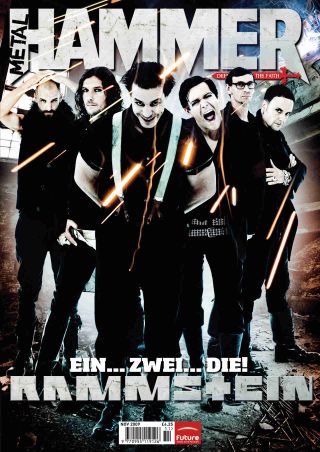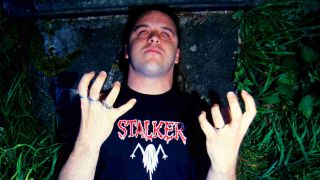Cannibal Corpse’s sixth album, 1998’s Gallery Of Suicide, discovered the dying metallic mainstays ploughing the identical bloodied, gore-filled furrow whereas the remainder of the world focussed its consideration on nu metallic. In 2009, frontman George ‘Corpsegrinder’ Fisher and bassist Alex Webster regarded again on the album that helped preserve dying metallic alive within the ’90s.
Steel strikes in cycles, similar to the whole lot else. Should you don’t imagine us, simply take heed to George ‘Corpsegrinder’ Fisher, the frontman of Cannibal Corpse, the goriest dying metallic band there’s ever been.
“In 1997, black metallic had risen and everybody had a dying metallic band!” says Corpsegrinder, “A few of them weren’t so good…”
Cannibal Corpse had been some of the profitable dying metallic acts on the earth for a few years at this level, regardless of – or maybe due to – the horrifically graphic nature of their songs. Their fifth album, Vile, appeared in 1996 and was the primary to characteristic Corpsegrinder, who had left his previous band Monstrosity to exchange CC’s first singer, Chris Barnes. Making historical past by touchdown on the underside finish of America’s Billboard chart, Vile made it clear that the brand new lineup meant enterprise.
Many metalheads had been fixated on the brand new wave of black metallic emanating from Scandinavia, the UK and the US. Simply as grunge had killed glam again in 1991, a brand new motion of corpsepainted bands was making the dying metallic scene look tedious, or worse, out of date. Solely the perfect would survive.
CC’s resolution was to document an album that may take the legacy of Vile, make it darker and extra atmospheric and show that dying metallic nonetheless had balls. It helped that the band had lastly come into their very own as musicians.
“By this level, we’d acquired a grip of our devices and we’d hit our stride,” bassist Alex Webster recollects. “Each album sounded tight, and by the point George joined the band we had been tuning decrease too.”
Required to play quicker, deeper and tighter than ever earlier than, CC hit a stroke of luck when considered one of their guitarists, Rob Barrett, departed after Vile and was changed by Pat O’Brien, a supremely technical participant – simply what they wanted with a view to re-stake their declare.
“It’s a loopy coincidence,” recollects Corpsegrinder, “as a result of Pat added method to the band that we didn’t have earlier than. We’re not super-technical, however we had been undoubtedly heading in that route.”

“When Rob left, we’d written about three songs for the brand new album,” Alex provides. “We carried on writing and took a few months earlier than we selected one other guitar participant. This was one change that we didn’t need to make in a rush, for as soon as! He left round February 1997, and we didn’t do any recording till October that 12 months.”
These days, when a band want a brand new guitar participant they simply ship out a number of emails, stick a submit on MySpace and the purposes roll in, however again then it was totally completely different.
“None of us had computer systems,” laughs Alex. “1997 was nonetheless approach earlier than the web age. None of us had computer systems till about 5 years in the past! We didn’t have cellphones, so there wasn’t actually a approach to get the phrase out – it simply unfold within the old-school approach of individuals listening to about it from this individual or that individual.”
From the off, Pat – then with melodic metallers Nevermore, a world away from the blood-freezing violence of Cannibal Corpse – was the plain contender to take over from Rob.
“I’d met Pat earlier than he got here right down to audition, as a result of we frolicked after I was nonetheless in Monstrosity,” remembers Corpsegrinder. “He was cool. He retains to himself.”
The truth is, Pat got here with many approvals.
“Our soundman mentioned that he knew him and that we should always meet him as a result of he was cool and into dying metallic,” says Alex. “Additionally Steve Tucker, who was in Morbid Angel on the time, had performed with Pat and really useful him, so there’s one other one who was pushing Pat in our route, and we ended up reaching out to him. As soon as he got here right down to Florida, it was clear that he was going to be the perfect man.”
Alex provides that Pat, who’s a type of big, silent geezers that it’s best to actually by no means irritate, is of course reserved.
“I’d most likely have been disconcerted by his seeming lack of enthusiasm, if I hadn’t been warned by a number of those that that’s simply how Pat is – he’s not going to be leaping round getting enthusiastic about issues!”
Despite his reserved outward look, Pat was eager to get to work, and got here to the primary periods for what would turn into Gallery Of Suicide with a completely shaped tune, Stabbed In The Throat. The monitor meshed immediately with these contributed by the remainder of the band, corresponding to Blood Drenched Execution, Dismembered And Molested and Each Bone Damaged, making Gallery… an hour-long symphony of cruelty. So the place did Cannibal get their concepts for these frankly terrifying songs?
“Simply by watching the information you will discover loads of inspiration – after which on prime of that you just’ve acquired all the nice horror films and novels on the market,” Alex explains. “There’s a vast quantity of unhealthy issues occurring on the earth, actual and imagined, so it’s not too onerous for us to give you stuff.”
As soon as the songs had been written, Cannibal moved right down to the well-known Morrisound studio in Tampa. Corpsegrinder remembers this time with a chuckle, saying, “I lived in a home with Paul [Mazurkiewicz, drummer] and one other buddy of mine, and it was a loopy time. We had been slobs and simply partying!”
When recording time got here round, nonetheless, the enjoyable and video games stopped: Cannibal had been there to reveal the fearsome abilities of their new lineup, and went into the studio periods with all weapons drawn. Producer Jim Morris had a shock coming to him, recollects Corpsegrinder, whose vocal supply was astounding.
“Jim did a fantastic job. I talked with him about a few of the lyrics and he was dying with laughter! One time, he was laughing whereas I used to be recording – so I mentioned, ‘Dude, did I mess up?’ and he mentioned, ‘No, no – how are you doing this? What the fuck are you doing? These lyrics are uncontrolled…’ There’s some quick shit on there!”

The songs had been laid down one after the other, with all-time classics corresponding to I Will Kill You and Centuries Of Torment becoming a member of Cannibal classics like 1993’s Hammer Smashed Face. A number of of the songs, notably the title monitor and From Pores and skin To Liquid, which offers with the topic of human decomposition, contained atmospheric sections that contrasted with the warp-speed blast- and-roar that followers had come to count on.
“Gallery… is without doubt one of the most experimental albums we’ve executed,” Corpsegrinder explains. “The title monitor itself is a little bit bit completely different: some components are virtually black metal-ish with blastbeats. It wasn’t on goal – it simply turned out that approach.”
Though Cannibal Corpse hadn’t supposed their album to attraction to black metallic followers, that sector of the head- banging group heard the darker, extra considerate aspect of Gallery Of Suicide and preferred it. As well as, each dying and black metallic bands had been seen for the primary time on the identical payments at about this time.
“We performed on some sensible tour packages, like with Marduk and Darkish Funeral,” says Alex. “Black and dying metallic come from the very same roots, from mid-80s stuff like Sodom, Kreator, Celtic Frost and Possessed, so there was no purpose why they couldn’t tour collectively, and that labored out very well.”
The ultimate step was the paintings. As with most CC covers, Gallery Of Suicide boasted a extremely specific cowl, designed by the band’s long-time sleeve artist Vincent Locke. It depicts a grim dungeon through which a bunch of characters are hanging, capturing and disembowelling themselves.
“Folks go in there and commit suicide, and in the event you’re unlucky sufficient to be curious to see what this gallery is about, or loopy sufficient, you may go inside,” George explains.
A toned-down cowl with much less gore was additionally commissioned from Vincent for the advantage of high-street shops.
“I really like the censored cowl as a lot because the uncensored one,” Alex claims. “It’s actually darkish and eerie-looking.” After years of commissioning covers which can be a mix of horror and excessive artwork, Alex is relaxed in regards to the topic of censorship.

“Some day, each main world chief goes to have grown up with heavy metallic or hip-hop, and it’s not gonna pack the identical sort of worry for them, and so finally the entire censorship downside will extinguish itself. However in the meanwhile, it’s nonetheless round.”
After 11 years, how does Gallery Of Suicide sound to the band?
“Really I listened to it not way back as a result of we wished to listen to a few of the previous tracks, and I believe it’s actually good,” says Alex. “It’s one of many darkest albums we ever did: there’s darkish melodies, darkish lyrics… I imply, all our albums are darkish, with songs about homicide and so forth, however there’s one thing extra-dark about that one!”
And in the event you’re questioning whether or not Cannibal Corpse managed to beat the decline of dying metallic to reclaim their place on the prime of America’s excessive metallic scene, the reply is apparent. Wanting again, evidently the dying metallic motion wanted to rid itself of some lesser bands to maintain transferring ahead.
“A style of music can solely be a model new factor for a few years,” says Alex, “after which it turns into established, which is what had occurred with dying metallic by that time. We had been fortunate sufficient to have followers who stayed with us, so with the entire dip in dying metallic, we didn’t see it the identical approach that different bands did.”
“Demise metallic by no means went wherever,” Corpsegrinder concludes, with immense satisfaction. “Deicide, Immolation, Mortician, Morbid Angel and us – we had been all nonetheless on the market touring. We knew the followers nonetheless cared.”
We nonetheless do, Corpsegrinder, we nonetheless do.
Initially printed in Steel Hammer difficulty 198, October 2009

